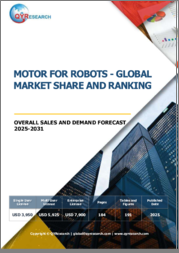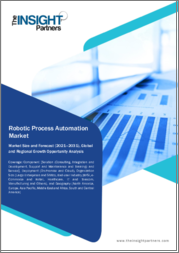
|
시장보고서
상품코드
1422832
피스 피킹 로봇 시장 보고서 : 로봇 유형, 최종사용자 및 지역별(2024-2032년)Piece Picking Robots Market Report by Robot Type (Collaborative, Mobile), End User (Pharmaceutical, Retail/Warehousing/Distribution Centers/Logistics Centers, and Others), and Region 2024-2032 |
||||||
2023년 피스 피킹 로봇 세계 시장 규모는 6억 5,200만 달러에 달했습니다. 향후 IMARC Group은 2032년까지 시장 규모가 319억 3,270만 달러에 달해 2024년부터 2032년까지 52.47%의 연평균 성장률(CAGR)을 기록할 것으로 예측했습니다. 산업 자동화의 새로운 트렌드, 물류 및 공급망 효율화에 대한 수요 증가, 인건비의 급격한 상승 등이 시장을 주도하는 주요 요인으로 꼽힙니다.
피스 피킹 로봇은 저장 시스템이나 창고에서 개별 제품 조각을 취급하고 피킹하도록 설계된 자동화 시스템입니다. 이 로봇은 첨단 센서, 그리퍼 및 컴퓨터 비전을 사용하여 고정밀하고 정확한 제품 식별 및 파악을 위해 첨단 센서, 그리퍼 및 컴퓨터 비전을 사용합니다. 피스 피킹 로봇의 특징은 높은 이동성, 다축 손재주, 다양한 모양과 크기의 물체를 조작할 수 있는 능력입니다. 피스 피킹 로봇은 E-Commerce 및 소매 기업의 창고 및 물류 센터에서 일반적으로 사용되며, 현대 공급망의 높은 수요를 충족시키기 위해 반복적이고 중요한 작업에 투입되는 수작업을 줄일 수 있습니다. 창고에서 피스 피킹 로봇을 사용하면 속도와 생산성이 향상되고, 인건비가 절감되며, 작업자가 무겁거나 위험한 물건을 다룰 필요가 없기 때문에 작업자의 안전이 향상됩니다. 이러한 소프트웨어 구동 및 하드웨어 지원 로봇은 다른 자동화 시스템과 통합할 수 있도록 설계되었으며, 신제품을 취급하거나 피킹 패턴을 변경하도록 쉽게 프로그래밍할 수 있습니다.
피스 피킹 로봇 시장 동향:
세계 시장 동향은 주로 인더스트리 4.0의 등장과 함께 산업 자동화의 새로운 트렌드에 의해 주도되고 있습니다. 이는 이동 거리를 최소화하고, 공간을 최대한 활용하고, 피킹 오류를 최소화하고, 소매점 직원의 부상을 최소화해야 할 필요성이 높아졌기 때문입니다. 이와 함께 E-Commerce 산업의 괄목할만한 성장으로 인해 물류 및 공급망 효율성 향상에 대한 수요가 증가하면서 시장에 유리한 성장 기회를 창출하고 있습니다. 또한, E-Commerce 인프라, 소형 매장, 옴니채널 풀필먼트의 상품 업스트림 처리 개발에 대한 투자가 증가하면서 시장 성장에 탄력이 붙고 있습니다. 또한, 로봇 팔 생산의 지속적인 기술 발전과 더 다양한 품목을 다루고 더 복잡한 환경에서 작동할 수 있는 새로운 소프트웨어 도구가 시장에 대한 밝은 전망을 만들어내고 있습니다. 여기에 개발 주기를 단축하고 실시간 가시성을 제공하기 위해 머신러닝(ML), 인공지능(AI), 클라우드 데이터 관리 시스템을 통합하는 추세도 시장에 긍정적인 영향을 미치고 있습니다. 또한, 전 세계적으로 인건비가 크게 상승하고 있는 것도 시장 성장에 힘을 실어주고 있습니다. 이 외에도 급속한 산업화, 가처분 소득 수준 상승, 주문량 및 출하량 증가, 로봇 공학의 수많은 기술 혁신 등도 시장에 기여하고 있습니다.
본 보고서에서 다루는 주요 질문
- 세계 피스 피킹 로봇 시장은 지금까지 어떻게 발전해 왔으며, 향후 몇 년 동안 어떻게 발전할 것인가?
- 세계 피스 피킹 로봇 시장에서 시장 촉진요인, 억제요인 및 기회는 무엇인가?
- 주요 지역 시장은?
- 가장 매력적인 피스 피킹 로봇 시장을 대표하는 국가는 어디일까?
- 로봇 유형별 시장 현황은?
- 최종사용자별 시장 분석은?
- 세계 피스 피킹 로봇 시장의 경쟁 구조는?
- 피스 피킹 로봇 세계 시장에서 주요 플레이어/기업은?
목차
제1장 서문
제2장 조사 범위와 조사 방법
- 조사 목적
- 이해관계자
- 데이터 소스
- 1차 정보
- 2차 정보
- 시장 추정
- 상향식 접근
- 하향식 접근
- 조사 방법
제3장 주요 요약
제4장 서론
- 개요
- 주요 산업 동향
제5장 피스 피킹 로봇 세계 시장
- 시장 개요
- 시장 실적
- COVID-19의 영향
- 시장 예측
제6장 시장 내역 : 로봇 유형별
- 협동
- 시장 동향
- 시장 예측
- 모바일
- 시장 동향
- 시장 예측
제7장 시장 내역 : 최종사용자별
- 의약품
- 시장 동향
- 시장 예측
- 소매/창고/유통 센터/물류 센터
- 시장 동향
- 시장 예측
- 기타
- 시장 동향
- 시장 예측
제8장 시장 내역 : 지역별
- 북미
- 미국
- 시장 동향
- 시장 예측
- 캐나다
- 시장 동향
- 시장 예측
- 미국
- 아시아태평양
- 중국
- 시장 동향
- 시장 예측
- 일본
- 시장 동향
- 시장 예측
- 인도
- 시장 동향
- 시장 예측
- 한국
- 시장 동향
- 시장 예측
- 호주
- 시장 동향
- 시장 예측
- 인도네시아
- 시장 동향
- 시장 예측
- 기타
- 시장 동향
- 시장 예측
- 중국
- 유럽
- 독일
- 시장 동향
- 시장 예측
- 프랑스
- 시장 동향
- 시장 예측
- 영국
- 시장 동향
- 시장 예측
- 이탈리아
- 시장 동향
- 시장 예측
- 스페인
- 시장 동향
- 시장 예측
- 러시아
- 시장 동향
- 시장 예측
- 기타
- 시장 동향
- 시장 예측
- 독일
- 라틴아메리카
- 브라질
- 시장 동향
- 시장 예측
- 멕시코
- 시장 동향
- 시장 예측
- 기타
- 시장 동향
- 시장 예측
- 브라질
- 중동 및 아프리카
- 시장 동향
- 시장 내역 : 국가별
- 시장 예측
제9장 SWOT 분석
- 개요
- 강점
- 약점
- 기회
- 위협
제10장 밸류체인 분석
제11장 Porter's Five Forces 분석
- 개요
- 구매자의 교섭력
- 공급 기업의 교섭력
- 경쟁 정도
- 신규 참여업체의 위협
- 대체품의 위협
제12장 가격 분석
제13장 경쟁 상황
- 시장 구조
- 주요 기업
- 주요 기업 개요
- Berkshire Grey Inc.
- Dematic(Kion Group AG)
- Fritz Schafer GmbH
- Hand Plus Robotics Pte. Ltd.
- Kindred Systems Inc.(Ocado Group)
- Knapp AG
- Nimble Robotics Inc.
- Osaro Inc.
- Righthand Robotics Inc.
- Swisslog Holding AG(kuka AG)
- Universal Robots A/S(Teradyne Inc.)
- XYZ Robotics Inc.
Abstract
The global piece picking robots market size reached US$ 652.0 Million in 2023. Looking forward, IMARC Group expects the market to reach US$ 31,932.7 Million by 2032, exhibiting a growth rate (CAGR) of 52.47% during 2024-2032. The emerging trend of industrial automation, escalating demand to enhance the efficiency of the logistics and supply chain, and considerable rise in the labor costs represent some of the key factors driving the market.
Piece picking robots are automated systems that are designed to handle and pick individual product pieces from a storage system or warehouse. These robots use advanced sensors, grippers, and computer vision to identify and grasp products with high precision and accuracy. Characteristics of piece picking robots include high mobility, multi-axis dexterity, and the ability to manipulate objects of varying shapes and sizes. They are commonly used in warehouses and distribution centers for e-commerce and retail companies to reduce manual labor to be devoted to repetitive and critical tasks in order to meet the high demands of modern supply chains. Using piece picking robots in warehouse provides enhanced speed and productivity, reduced labor costs, and higher worker safety by eliminating the need for workers to handle heavy or dangerous items. These software-driven, hardware-enabled robots are designed to integrate with other automated systems and can be easily programmed to handle new products or change pick patterns.
Piece Picking Robots Market Trends:
The global market is primarily driven by the emerging trend of industrial automation, along with the advent of industry 4.0. This can be attributed to the growing need to minimize travel distance, maximize the use of space, minimize pick errors, and minimize injuries among retail workers. In line with this, the escalating demand to enhance the efficiency of the logistics and supply chain due to significant growth in the e-commerce industry is creating lucrative growth opportunities in the market. Also, the rising investments in the development of upstream handling of products in e-commerce infrastructure, smaller format stores, and omnichannel fulfillment are providing an impetus to the market. Moreover, continual technological advancements in the production of robotic arms and new software tools to handle a wider range of items and operate in more complex environments are creating a positive outlook for the market. Besides this, the growing integration of machine learning (ML), artificial intelligence (AI), and cloud data management systems to shorten development cycles and offer real-time visibility is impacting the market positively. The market is further fueled by the considerable rise in the labor costs on the global level. Some of the other factors contributing to the market include rapid industrialization, inflating disposable income levels, increasing volumes of orders and shipments, and numerous innovations in robotics.
Key Market Segmentation:
IMARC Group provides an analysis of the key trends in each segment of the global piece picking robots market, along with forecasts at the global, regional, and country level from 2024-2032. Our report has categorized the market based on robot type and end user.
Robot Type Insights
Collaborative
Mobile
The report has provided a detailed breakup and analysis of the piece picking robots market based on the robot type. This includes collaborative and mobile. According to the report, collaborative represented the largest segment.
End User Insights
Pharmaceutical
Retail/Warehousing/Distribution Centers/Logistics Centers
Others
A detailed breakup and analysis of the piece picking robots market based on the department has also been provided in the report. This includes pharmaceutical, retail/warehousing/distribution centers/logistics centers, and others.
Regional Insights:
North America
United States
Canada
Europe
Germany
France
United Kingdom
Italy
Spain
Russia
Others
Asia Pacific
China
Japan
India
South Korea
Australia
Indonesia
Others
Latin America
Brazil
Mexico
Others
Middle East and Africa
The report has also provided a comprehensive analysis of all the major regional markets that include North America (the United States and Canada); Asia Pacific (China, Japan, India, South Korea, Australia, Indonesia, and others); Europe (Germany, France, the United Kingdom, Italy, Spain, Russia, and others); Latin America (Brazil, Mexico, and others); and Middle East and Africa. According to the report, North America was the largest market for piece picking robots. Some of the factors driving the North America piece picking robots market include rapid industrialization, inflating disposable income levels, significant growth in the e-commerce industry, etc.
Competitive Landscape
The report has also provided a comprehensive analysis of the competitive landscape in the global piece picking robots market. Detailed profiles of all major companies have also been provided. Some of the companies covered include Berkshire Grey Inc., Dematic (Kion Group AG), Fritz Schafer GmbH, Hand Plus Robotics Pte. Ltd., Kindred Systems Inc. (Ocado Group), Knapp AG, Nimble Robotics Inc., Osaro Inc., Righthand Robotics Inc., Swisslog Holding AG (kuka AG), Universal Robots A/S (Teradyne Inc.), XYZ Robotics Inc., etc.
Key Questions Answered in This Report:
- How has the global piece picking robots market performed so far and how will it perform in the coming years?
- What are the drivers, restraints, and opportunities in the global piece picking robots market?
- What are the key regional markets?
- Which countries represent the most attractive piece picking robots markets?
- What is the breakup of the market based on the robot type?
- What is the breakup of the market based on the end user?
- What is the competitive structure of the global piece picking robots market?
- Who are the key players/companies in the global piece picking robots market?
Table of Contents
1 Preface
2 Scope and Methodology
- 2.1 Objectives of the Study
- 2.2 Stakeholders
- 2.3 Data Sources
- 2.3.1 Primary Sources
- 2.3.2 Secondary Sources
- 2.4 Market Estimation
- 2.4.1 Bottom-Up Approach
- 2.4.2 Top-Down Approach
- 2.5 Forecasting Methodology
3 Executive Summary
4 Introduction
- 4.1 Overview
- 4.2 Key Industry Trends
5 Global Piece Picking Robots Market
- 5.1 Market Overview
- 5.2 Market Performance
- 5.3 Impact of COVID-19
- 5.4 Market Forecast
6 Market Breakup by Robot Type
- 6.1 Collaborative
- 6.1.1 Market Trends
- 6.1.2 Market Forecast
- 6.2 Mobile
- 6.2.1 Market Trends
- 6.2.2 Market Forecast
7 Market Breakup by End User
- 7.1 Pharmaceutical
- 7.1.1 Market Trends
- 7.1.2 Market Forecast
- 7.2 Retail/Warehousing/Distribution Centers/Logistics Centers
- 7.2.1 Market Trends
- 7.2.2 Market Forecast
- 7.3 Others
- 7.3.1 Market Trends
- 7.3.2 Market Forecast
8 Market Breakup by Region
- 8.1 North America
- 8.1.1 United States
- 8.1.1.1 Market Trends
- 8.1.1.2 Market Forecast
- 8.1.2 Canada
- 8.1.2.1 Market Trends
- 8.1.2.2 Market Forecast
- 8.1.1 United States
- 8.2 Asia-Pacific
- 8.2.1 China
- 8.2.1.1 Market Trends
- 8.2.1.2 Market Forecast
- 8.2.2 Japan
- 8.2.2.1 Market Trends
- 8.2.2.2 Market Forecast
- 8.2.3 India
- 8.2.3.1 Market Trends
- 8.2.3.2 Market Forecast
- 8.2.4 South Korea
- 8.2.4.1 Market Trends
- 8.2.4.2 Market Forecast
- 8.2.5 Australia
- 8.2.5.1 Market Trends
- 8.2.5.2 Market Forecast
- 8.2.6 Indonesia
- 8.2.6.1 Market Trends
- 8.2.6.2 Market Forecast
- 8.2.7 Others
- 8.2.7.1 Market Trends
- 8.2.7.2 Market Forecast
- 8.2.1 China
- 8.3 Europe
- 8.3.1 Germany
- 8.3.1.1 Market Trends
- 8.3.1.2 Market Forecast
- 8.3.2 France
- 8.3.2.1 Market Trends
- 8.3.2.2 Market Forecast
- 8.3.3 United Kingdom
- 8.3.3.1 Market Trends
- 8.3.3.2 Market Forecast
- 8.3.4 Italy
- 8.3.4.1 Market Trends
- 8.3.4.2 Market Forecast
- 8.3.5 Spain
- 8.3.5.1 Market Trends
- 8.3.5.2 Market Forecast
- 8.3.6 Russia
- 8.3.6.1 Market Trends
- 8.3.6.2 Market Forecast
- 8.3.7 Others
- 8.3.7.1 Market Trends
- 8.3.7.2 Market Forecast
- 8.3.1 Germany
- 8.4 Latin America
- 8.4.1 Brazil
- 8.4.1.1 Market Trends
- 8.4.1.2 Market Forecast
- 8.4.2 Mexico
- 8.4.2.1 Market Trends
- 8.4.2.2 Market Forecast
- 8.4.3 Others
- 8.4.3.1 Market Trends
- 8.4.3.2 Market Forecast
- 8.4.1 Brazil
- 8.5 Middle East and Africa
- 8.5.1 Market Trends
- 8.5.2 Market Breakup by Country
- 8.5.3 Market Forecast
9 SWOT Analysis
- 9.1 Overview
- 9.2 Strengths
- 9.3 Weaknesses
- 9.4 Opportunities
- 9.5 Threats
10 Value Chain Analysis
11 Porters Five Forces Analysis
- 11.1 Overview
- 11.2 Bargaining Power of Buyers
- 11.3 Bargaining Power of Suppliers
- 11.4 Degree of Competition
- 11.5 Threat of New Entrants
- 11.6 Threat of Substitutes
12 Price Analysis
13 Competitive Landscape
- 13.1 Market Structure
- 13.2 Key Players
- 13.3 Profiles of Key Players
- 13.3.1 Berkshire Grey Inc.
- 13.3.1.1 Company Overview
- 13.3.1.2 Product Portfolio
- 13.3.2 Dematic (Kion Group AG)
- 13.3.2.1 Company Overview
- 13.3.2.2 Product Portfolio
- 13.3.3 Fritz Schafer GmbH
- 13.3.3.1 Company Overview
- 13.3.3.2 Product Portfolio
- 13.3.4 Hand Plus Robotics Pte. Ltd.
- 13.3.4.1 Company Overview
- 13.3.4.2 Product Portfolio
- 13.3.5 Kindred Systems Inc. (Ocado Group)
- 13.3.5.1 Company Overview
- 13.3.5.2 Product Portfolio
- 13.3.6 Knapp AG
- 13.3.6.1 Company Overview
- 13.3.6.2 Product Portfolio
- 13.3.7 Nimble Robotics Inc.
- 13.3.7.1 Company Overview
- 13.3.7.2 Product Portfolio
- 13.3.8 Osaro Inc.
- 13.3.8.1 Company Overview
- 13.3.8.2 Product Portfolio
- 13.3.9 Righthand Robotics Inc.
- 13.3.9.1 Company Overview
- 13.3.9.2 Product Portfolio
- 13.3.10 Swisslog Holding AG (kuka AG)
- 13.3.10.1 Company Overview
- 13.3.10.2 Product Portfolio
- 13.3.11 Universal Robots A/S (Teradyne Inc.)
- 13.3.11.1 Company Overview
- 13.3.11.2 Product Portfolio
- 13.3.12 XYZ Robotics Inc.
- 13.3.12.1 Company Overview
- 13.3.12.2 Product Portfolio
- 13.3.1 Berkshire Grey Inc.



















